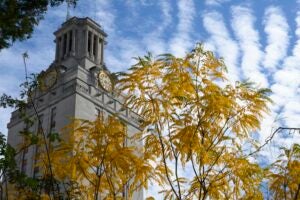
Thirty of the most iconic works by world-renowned photographer Ansel Adams will be on display at The University of Texas at Austin’s Harry Ransom Center beginning Aug. 31. His work will be showcased alongside those of his predecessors and of the generations of artists he influenced and inspired. “Visualizing the Environment: Ansel Adams and His Legacy” addresses important subjects such as environmental change over time and the aftermath of environmental destruction while highlighting the lasting impact of this singular photographer.
“‘Visualizing the Environment: Ansel Adams and His Legacy’ places the work of Adams within a tradition of photographic practice that he helped to define,” said Ransom Center Director Stephen Enniss. “The exhibition allows us to see and appreciate anew the artistry of his contribution to that tradition and recognize his role in shaping an emerging environmental consciousness of his day and ours. We are delighted to place the work of this beloved figure in American photography in dialogue with his peers in this way.”
Adams described his approach to picture-making as one of “visualization” — the photographic expression of what the environment looks and feels like to the artist. “The first step towards visualization, and hence toward expressive interpretation,” Adams said, “is to become aware of the world around us in terms of the photographic image. We must teach our eyes to become more perceptive.”
“Ansel Adams, one of the master landscape photographers of the 20th century, becomes especially interesting when you view his work alongside others who also care deeply about the environment,” said Dr. Steven D. Hoelscher, Faculty Curator of Photography, Harry Ransom Center, and Stiles Professor of American Studies and Geography, who served as faculty curator for this exhibit. “My hope is that viewers of these amazing photographs will be inspired to reflect on their own connections to the environment.”
His intensely personal perspective celebrated the vast, open spaces of the American West, as he depicted those environments with a sublime and operatic vision. This vision was also charged with moral conviction in the ability of beautifully made photographs to inspire awe. And it was political: His photographs of pristine, untouched environments were instrumental in promoting the preservationist vision of the Sierra Club to the American public. His unique way of making photographs is best understood when shown alongside those who came before and those who have followed.
For Adams’ contemporaries and more recent photographers, his legacy looms large. His photographs have inspired environmental consciousness for many. But a large number of those influenced by Adams have chosen to photograph exactly what he left out of his visualizations: the impact of humans on the natural environment. By removing evidence of the human impact on the Earth, Adams presented a particular vision of the environment that contemporary photographers have sought to counter.
Trying to visualize the environment in ways that represent myriad realities of “place” has become a hallmark of photography in recent decades. The photographs on display take on many forms and address a wide range of topics, including destruction and degradation, change over time, the connection of home to place, historical memory and aesthetic beauty. In nearly every case, rather than separating cultures and societies from the environment, contemporary environmental visualizations explore their connection.
Adams’ photographs of pristine nature remain some of the most popular and immediately recognizable environmental images of our time. “Visualizing the Environment: Ansel Adams and His Legacy” will share Adams’ photography with a new generation, one that cares deeply about contemporary environmental issues.
“Visualizing the Environment: Ansel Adams and His Legacy” will be on view through Feb. 2 and is sponsored in partnership with the Still Water Foundation. More information online at hrc.utexas.edu.



